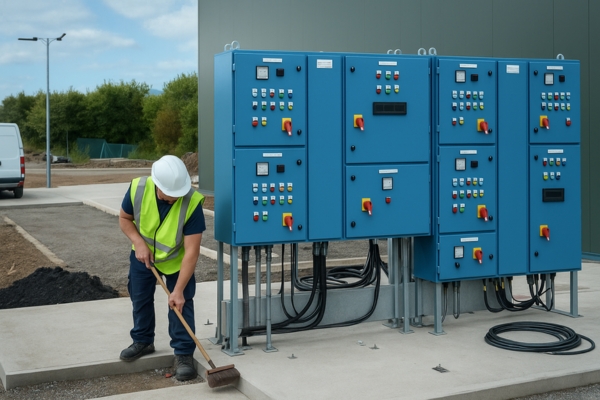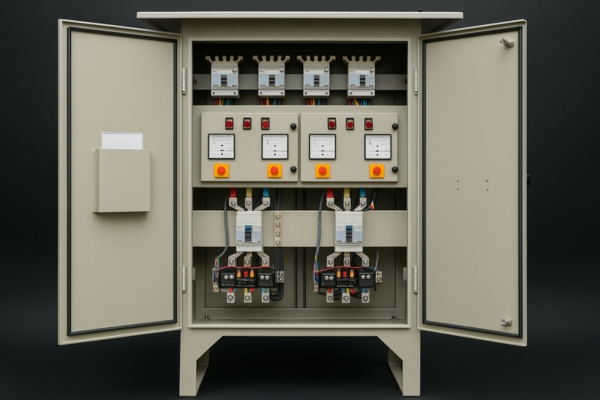Common Mistakes to Avoid When Installing Feeder Pillar Panels

In electrical distribution systems, few components are as vital as the feeder pillar panel. This outdoor enclosure serves as a central hub for controlling and distributing power to various circuits. It connects transformers, generators, and load points, making it a crucial link in power supply management.
However, mistakes during installation can cause system failures, costly repairs, or safety risks. Whether you’re an electrical contractor, project engineer, or end-user, knowing the common errors helps you avoid downtime and financial loss.
In this article, we’ll explain the frequent mistakes seen in feeder pillar panel installations and how to avoid them.
Poor Site Selection for Feeder Pillar Panel Installation

Choosing the right location is more than just finding an open space. The wrong site can cause long-term operational problems.
Considerations Before Placement:
- Select areas with minimal flooding risk.
- Avoid spots exposed to direct waterlogging or heavy debris.
- Ensure there is easy access for maintenance teams.
- Install on a level, stable surface with strong foundation support.
Placing panels in low-lying areas often leads to moisture ingress, electrical short circuits, and eventual failure. Always plan for site drainage and accessibility.
Neglecting Correct Earthing and Bonding
Effective earthing is not just a standard; it is a critical safety requirement. Many installations suffer because this is rushed or poorly executed.
Common Errors in Earthing:
- Using undersized earth conductors.
- Poor connection quality leading to loose contacts.
- Absence of earth testing after installation.
A weak earthing system compromises safety, increases shock risk, and reduces protection for equipment. Always follow statutory regulations and use tested, high-conductivity earth materials.
Ignoring Weatherproofing Standards
A feeder pillar panel is typically installed outdoors, making it highly vulnerable to harsh weather.
Mistakes to Avoid:
- Installing panels without IP-rated enclosures suitable for outdoor use.
- Skipping rubber gaskets or protective sealing materials.
- Overlooking ventilation needs while trying to make it watertight.
A weatherproof panel guards against dust, moisture, and corrosion. Choose enclosures tested for specific environments, whether coastal, industrial, or high rainfall regions.
Incorrect Cable Entry and Glanding
Cable management is more than just neatness it directly affects panel life and operation.
Common Cable Handling Mistakes:
- Using improper gland sizes leading to poor sealing.
- Lack of cable bending space, causing stress on terminals.
- Forgetting to tighten cable glands securely.
- No use of proper bushings or sealing rings.
These mistakes often cause water ingress, mechanical stress on cables, and even operational faults. Always use the correct gland size and ensure secure, strain-free cable entry.
Overlooking Load Calculations and Future Expansion
A feeder pillar panel is not a set-it-and-forget-it device. Poor load planning can cause overloading, tripping, or even panel damage.
Where Installations Go Wrong:
- Failing to calculate peak load requirements.
- Ignoring the possibility of future load additions.
- Under-sizing busbars or protection devices.
Careful load assessment ensures reliable operation and reduces maintenance issues. Allow room for expansion during the design stage to avoid costly future upgrades.
Skipping Pre-Installation Testing and Inspection
Installation is not just about fixing the panel in place. Testing and inspection are vital steps that many skip.
Testing to be Done Before Commissioning:
- Insulation resistance testing for wiring and components.
- Earthing resistance measurement.
- Functionality checks of breakers, fuses, and isolators.
- Mechanical inspections for tightness of connections.
Failing to do this leads to undetected faults, which often surface only during operation when it’s too late.
Improper Coordination with Utility and Site Engineers
Electrical systems don’t operate in isolation. Poor communication with relevant stakeholders can lead to installation errors.
Common Coordination Gaps:
- Not consulting with utility supply providers.
- Overlooking site layout restrictions.
- Ignoring local regulations and inspection requirements.
Coordination ensures compliance, operational efficiency, and avoids rework. Always involve all stakeholders early in the planning process.
Using Substandard Components or Low-Quality Materials
Saving costs on components often backfires. Using uncertified or low-grade materials increases the risk of failure.
Mistakes in Material Selection:
- Choosing non-standard busbars, connectors, or cables.
- Ignoring certifications like ISI, CE, or IEC standards.
- Buying from unverified suppliers.
Always opt for quality components from reputed manufacturers. The initial cost saves you far more in reduced downtime and maintenance later.
Failing to Follow Manufacturer’s Installation Guidelines
Each feeder pillar panel may have unique installation needs based on design and use. Ignoring manufacturer’s guidelines is a recipe for operational trouble.
What Gets Overlooked:
- Recommended torque settings for terminals.
- Specified protection devices.
- Environmental operating conditions.
Review technical manuals thoroughly and follow guidelines strictly. Manufacturers like DJ Electro Control provide detailed instructions that help prevent common mistakes.
Lack of Routine Maintenance Post-Installation
Installation is only the beginning. Feeder pillar panels need regular inspection and upkeep.
Typical Post-Installation Oversights:
- Not scheduling routine inspections.
- Ignoring early signs of wear or corrosion.
- Skipping electrical testing intervals.
A proper maintenance plan prolongs panel life and ensures reliable operation. Maintenance is as vital as installation itself.
Frequently Asked Questions
Q1: Why is proper earthing important in a feeder pillar panel installation?
Answer: Earthing protects both equipment and users by ensuring fault currents are safely discharged into the ground. Poor earthing can result in shocks, equipment failure, or fires.
Q2: How can I select the right site for installing a feeder pillar panel?
Answer: Choose a location that is easily accessible, free from waterlogging risks, and has a stable foundation. Always plan for maintenance access and protection against environmental factors.
Q3: What weatherproof standards should I check for in a feeder pillar panel?
Answer: Look for IP-rated enclosures suitable for outdoor use. Ensure the panel has proper sealing, protection against dust, moisture, and corrosive environments.
Q4: Why is correct cable gland selection critical in installation?
Answer: Correct glands protect against water ingress, mechanical strain, and electrical faults. They ensure safety and extend the panel’s lifespan by maintaining sealing integrity.
Q5: How often should I schedule maintenance checks for my feeder pillar panel?
Answer: Routine maintenance should be done at least every six months or as per manufacturer recommendations. Regular checks prevent unexpected breakdowns and prolong equipment life.
Q6: What certifications should I look for when buying feeder pillar panels?
Answer: Always check for ISI, CE, or IEC certifications, which assure that the product meets safety and performance standards required for electrical installations.
Q7: Why is future load consideration important during installation?
Answer: Planning for future load prevents overloading, reduces the need for early upgrades, and saves long-term costs. Always leave capacity for expansion when designing the system.
Conclusion
Installing a feeder pillar panel may seem straightforward, but it involves detailed planning and strict adherence to safety standards. By avoiding the common mistakes listed above, you not only ensure reliable operation but also protect your investment.
For those seeking high-quality panels with proven performance, DJ Electro Control offers a trusted range of feeder pillar panels designed for diverse industrial needs.
If you are looking for professional guidance on installation or need durable panels built to last, contact our team today. We are here to support your electrical project needs.

